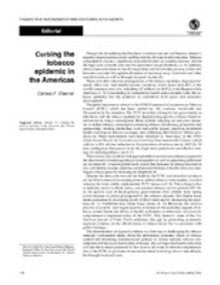Though the devastating health effects of tobacco use are well known, tobacco’s negative repercussions extend well beyond the obvious health outcomes. Tobacco consumption creates a significant economic burden on societies because of both the high costs of health care and the associated lost productivity. In addition, tobacco use contributes to health inequalities and exacerbates poverty within and between countries through the diversion of resources away from food and other essential needs as well as through foregone income. These and other adverse consequences of the tobacco epidemic disproportionately affect low- and middle-income countries, where more than 80% of the world’s smokers now live, including 127 million (or 11.4%), in the Region of the Americas. Considering its tremendous health and economic costs, the tobacco epidemic has the potential to undermine both social and economic development. The global response to tobacco is the WHO Framework Convention on Tobacco Control (FCTC), which has been ratified by 180 countries worldwide and 30 countries in the Americas. The FCTC provides a blueprint for governments to effectively curb the tobacco epidemic by implementing specific evidence-based interventions to reduce consumption. These include: adopting tax and price measures to reduce tobacco consumption; banning tobacco advertising, promotion and sponsorship; creating smoke-free work and public spaces; requiring prominent health warnings on tobacco packages; and combating illicit trade in tobacco products. These interventions have been identified as “best buys” in the WHO Global Action Plan for the Prevention and Control of Noncommunicable Diseases, which calls for a 30% relative reduction in the prevalence of tobacco use by 2025. Of note, raising taxes has proven to be the single most potent and cost-effective strategy for reducing tobacco use...
|

